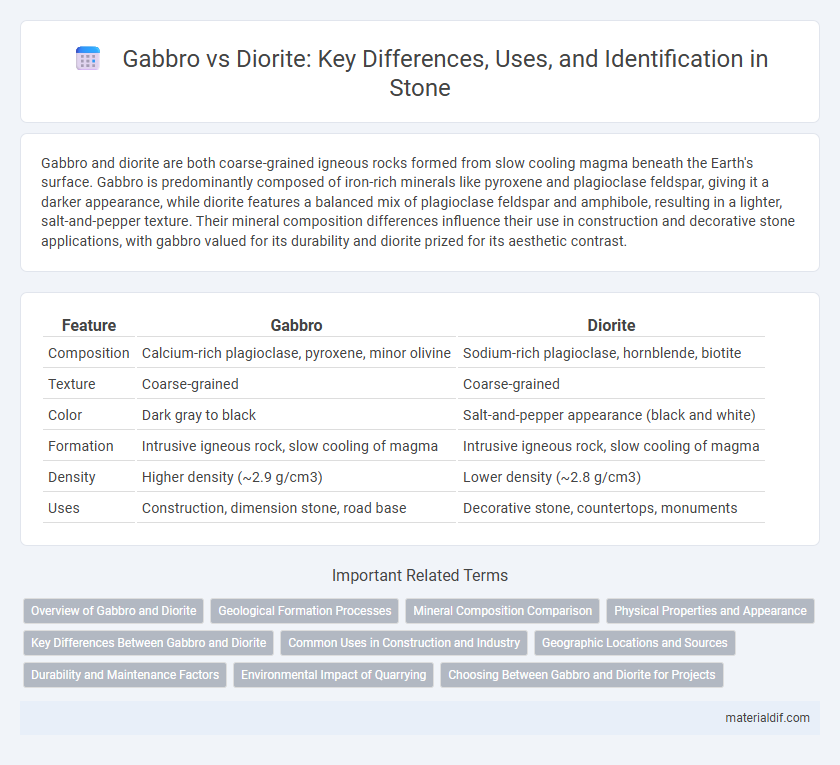Gabbro and diorite are both coarse-grained igneous rocks formed from slow cooling magma beneath the Earth's surface. Gabbro is predominantly composed of iron-rich minerals like pyroxene and plagioclase feldspar, giving it a darker appearance, while diorite features a balanced mix of plagioclase feldspar and amphibole, resulting in a lighter, salt-and-pepper texture. Their mineral composition differences influence their use in construction and decorative stone applications, with gabbro valued for its durability and diorite prized for its aesthetic contrast.
Table of Comparison
| Feature | Gabbro | Diorite |
|---|---|---|
| Composition | Calcium-rich plagioclase, pyroxene, minor olivine | Sodium-rich plagioclase, hornblende, biotite |
| Texture | Coarse-grained | Coarse-grained |
| Color | Dark gray to black | Salt-and-pepper appearance (black and white) |
| Formation | Intrusive igneous rock, slow cooling of magma | Intrusive igneous rock, slow cooling of magma |
| Density | Higher density (~2.9 g/cm3) | Lower density (~2.8 g/cm3) |
| Uses | Construction, dimension stone, road base | Decorative stone, countertops, monuments |
Overview of Gabbro and Diorite
Gabbro and diorite are coarse-grained igneous rocks formed from the slow cooling of magma beneath the Earth's surface. Gabbro predominantly consists of calcium-rich plagioclase feldspar and pyroxene, giving it a darker, denser composition often associated with oceanic crust. Diorite contains a higher proportion of sodium-rich plagioclase and hornblende or biotite, resulting in a lighter, more intermediate color and granitic texture commonly found in continental crust.
Geological Formation Processes
Gabbro and diorite are both intrusive igneous rocks formed from the slow cooling of magma beneath the Earth's surface, resulting in coarse-grained textures. Gabbro originates from mafic magma rich in iron and magnesium, typically forming in oceanic crust and layered mafic intrusions, whereas diorite forms from intermediate magma with higher silica content, commonly associated with volcanic arcs and continental margins. Differences in mineral composition, mainly the abundance of plagioclase feldspar and ferromagnesian minerals, reflect their distinct geological formation environments and tectonic settings.
Mineral Composition Comparison
Gabbro primarily consists of calcium-rich plagioclase feldspar and abundant pyroxene minerals, giving it a darker, dense texture, while diorite features a balance of sodium-rich plagioclase feldspar and hornblende amphiboles, resulting in a lighter, speckled appearance. The mineral composition of gabbro typically includes olivine in some varieties, whereas diorite rarely contains olivine, emphasizing its intermediate silica content between mafic gabbro and felsic granite. These differences in mineralogy influence the color, density, and durability of each rock, making gabbro more mafic and diorite more intermediate in the igneous rock classification.
Physical Properties and Appearance
Gabbro is a coarse-grained intrusive igneous rock characterized by its dark green to black color and high density due to abundant pyroxene and plagioclase feldspar minerals. Diorite displays a salt-and-pepper appearance with a mix of light and dark minerals, predominantly plagioclase feldspar and hornblende, resulting in a medium-grained texture and lighter gray color. Both rocks have similar hardness around 6 to 7 on the Mohs scale, but gabbro's darker color and higher iron content distinguish it from the more speckled and lighter diorite.
Key Differences Between Gabbro and Diorite
Gabbro and diorite are both coarse-grained igneous rocks but differ primarily in mineral composition; gabbro is rich in calcium-rich plagioclase and pyroxene, giving it a darker appearance, while diorite contains more sodium-rich plagioclase and hornblende, resulting in a lighter color. The texture of gabbro tends to be more uniform with a dense structure, whereas diorite often exhibits a speckled or salt-and-pepper look due to the contrasting light and dark minerals. Chemically, gabbro is mafic with higher iron and magnesium content, whereas diorite lies between mafic and felsic compositions, making it intermediate in silica content and mineral diversity.
Common Uses in Construction and Industry
Gabbro is commonly used in construction for road base materials, crushed stone, and dimension stone due to its durability and coarse-grained texture, making it suitable for heavy-duty applications. Diorite finds frequent use in construction as decorative stone, countertops, and in monument building, prized for its attractive speckled appearance and hardness. Both stones serve important roles in industry, with gabbro often employed in aggregate production and diorite utilized in architectural and ornamental stone works.
Geographic Locations and Sources
Gabbro primarily forms in oceanic crust regions, with significant deposits found in the Mid-Atlantic Ridge and the Sierra Nevada in the United States. Diorite is commonly sourced from continental crust areas, particularly in mountain ranges like the Andes in South America and the Scottish Highlands. These geographic distinctions influence their mineral composition and industrial applications.
Durability and Maintenance Factors
Gabbro exhibits superior durability compared to diorite due to its dense, coarse-grained composition, making it highly resistant to weathering and wear. Maintenance for gabbro is minimal since its low porosity reduces staining and moisture absorption, whereas diorite requires more regular sealing to prevent surface damage and maintain appearance. Both stones offer robust strength, but gabbro's resilience and ease of upkeep make it preferable for high-traffic or exterior applications.
Environmental Impact of Quarrying
Quarrying gabbro and diorite both result in significant landscape alteration and habitat disruption, with gabbro extraction often requiring deeper excavation due to its coarse grain and hardness, leading to increased energy consumption. Diorite quarrying tends to generate higher dust emissions because of its finer grain structure, impacting local air quality and vegetation. Both stones necessitate careful management strategies to mitigate soil erosion, water pollution, and biodiversity loss in quarrying sites.
Choosing Between Gabbro and Diorite for Projects
Gabbro offers higher durability and coarse-grained texture, making it ideal for heavy construction projects and exterior applications where strength is essential. Diorite, with its attractive salt-and-pepper appearance and slightly finer grain, suits decorative interior stonework and architectural details. Choosing between gabbro and diorite depends on project requirements for strength, aesthetics, and exposure conditions.
Gabbro vs Diorite Infographic

 materialdif.com
materialdif.com